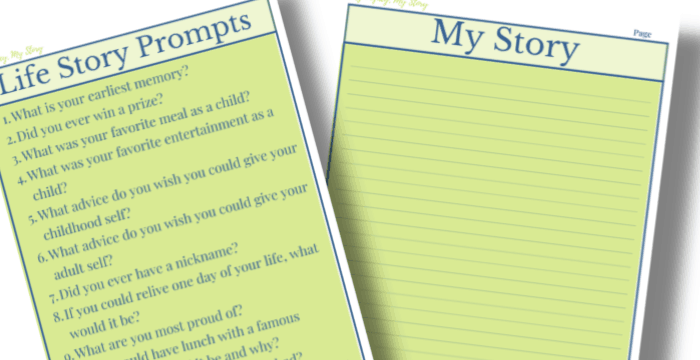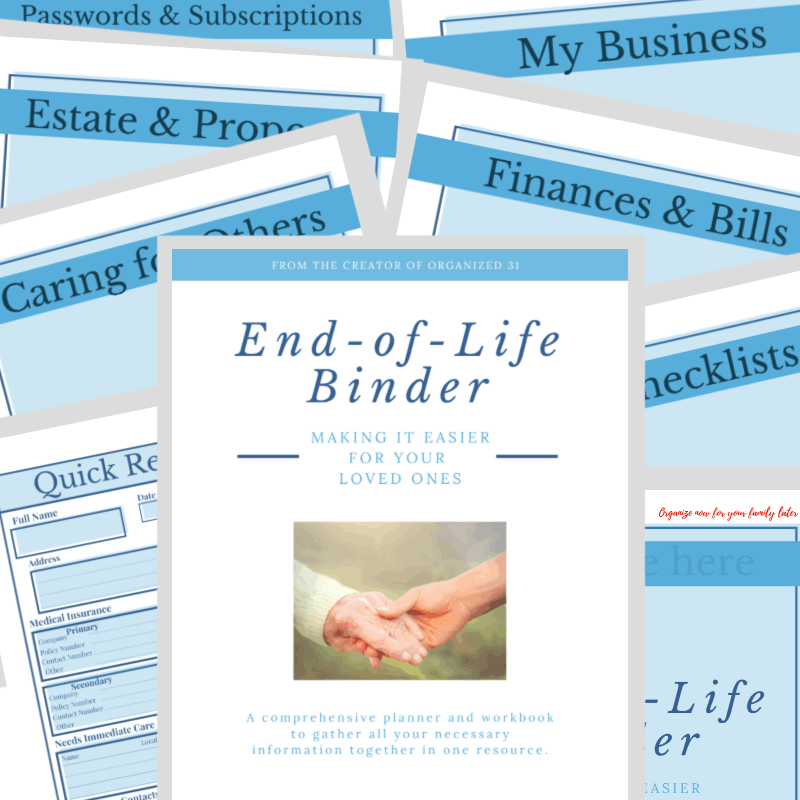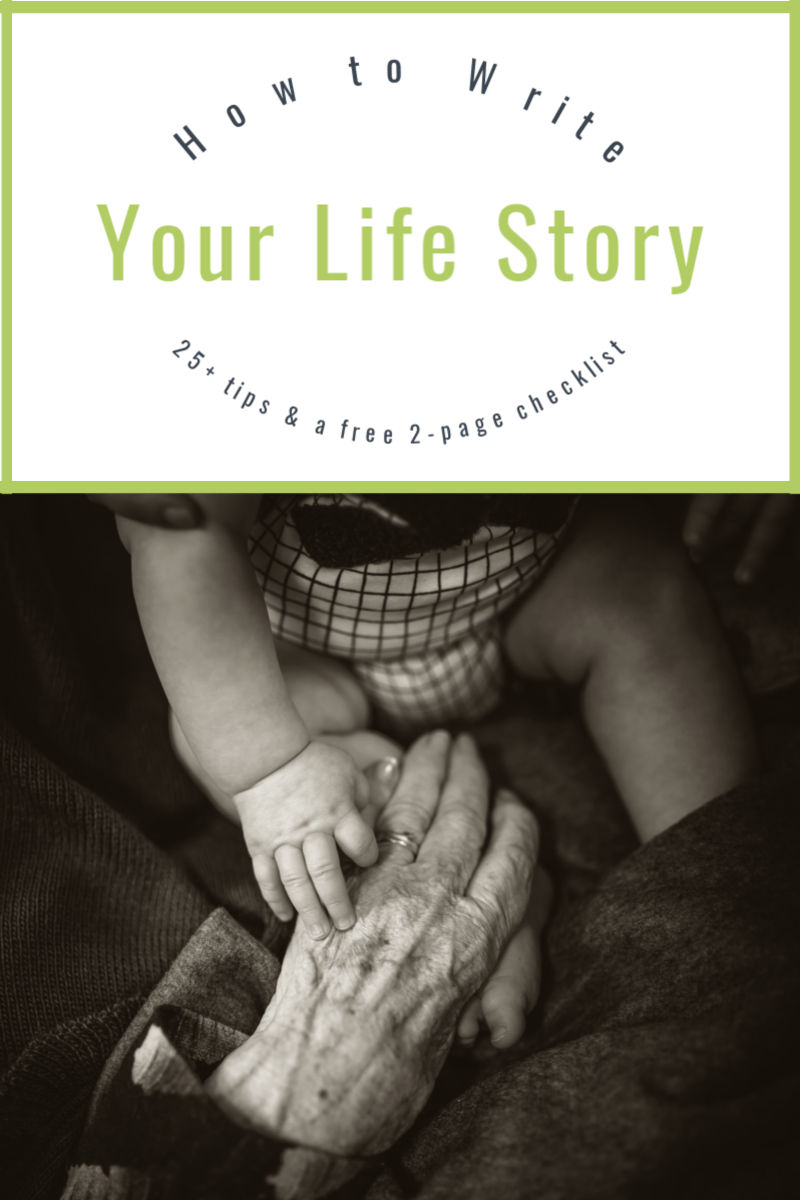You leave a precious gift for your family when you know how to write your life story. Your family will treasure your stories, thoughts and advice when you write them down or record them.
It is not a complicated process when you take it step-by-step. These more than 25 tips and free 2-page printable take the overwhelm out of sharing your legacy story with your family.

What Is Legacy Writing?
Your life is filled with unique experiences, view points and advice. It’s a beautiful gift for your family and ancestors when you record your thoughts and life story through legacy writing.
Your Life Story is a gift to yourself and to your loved ones. Your family will read or listen to your Life Story again and again. It will be valued by your ancestors for years and even centuries to come.
These simple prompts and the free 2-page printable make writing your life story easy.
How to Write Your Life Story
- Determine your why.
- What is the reason you’re recording your life story?
- What do you want to share with your loved ones?
- What unique experiences have you had?
- What historic events did you experience that should be shared?
- What do you want to be remembered for?
- What memories of your parents, grandparents and extended family do you want to share?
- What family traditions and values do you want pass on?
- Determine if you want to write, type or record your Life Story.
- How you record your legacy story isn’t important. Getting your story down and recorded is the goal.
- Choose the method that will be most comfortable for you:
- Handwritten – Your family will cherish having your story recorded in your own handwriting. But be aware that it can be physically exhausting to write out your life story.
- Type – You can type out your story on your computer (or even a typewriter, if you still have one). Make sure you feel comfortable using the technology.
- Audio Recording – It is often easier to simply tell your story and record it. Your family will treasure a recording of your story in your very own voice. If you choose audio recording, familiarize yourself with the recording device or app before you begin. Save your recordings frequently.
- Video Recording – It can be easier to tell your story by talking through it. Watching you share your life story will be a priceless gift for your family. If you choose video recording, make sure you are thoroughly familiar with the recording device or app before you begin and save your recordings frequently.
- Consider having a child or grandchild help you if you are using technology you’re not comfortable using. The time you spend together will be precious to you both.
- Schedule a regular time to write.
- You won’t be able to write your Life Story in one afternoon.
- Decide how often and how long you will spend at each session.
- Schedule your legacy story writing on your calendar as a regular activity.
- Use legacy writing prompts to get started.
- Pull out photos and other mementos to help you write your memories.
- Use the legacy writing prompts below to stimulate your writing.
My Legacy Writing Prompts
- Share memories from your childhood.
- Share memories of your parents and grandparents.
- Share your interests and hobbies.
- Share historic events you lived through and your personal experiences.
- Share about your friends and loves.
- Share your advice for life.
- Share your thoughts on what is most important in life.
- Share your favorite foods, music, movies, etc.
- Share how much items cost in your childhood.
- Share what you’re most proud of in your life.

You can download 12 Life Story writing prompts and a My Story notes page by simply signing up for our weekly newsletter.
- Record your story as though you’re talking with a friend or family member.
- Don’t worry about your writing or speaking style. Your family wants to hear your story in your own voice.
- Don’t worry about scratching out mistakes or stumbling a bit when speaking. Mistakes are just part of life. Your family is most interested in hearing your stories.
- Take notes at the end of each session so you know where to pick up the story the next time you start again.
- Be sure to back up your saved work during and after each session.
Create a Keepsake Version of Your Life Story
- Write or print your legacy story on a nicer quality paper. It’s really not that much more expensive than computer paper, but it will hold up better over time and turns your printed pages into a quality keepsake.
- You can print on your own printer or take your story to an office supply store to be printed.
- You can place your printed story in a binder, with page protectors or not. You can also have it bound at your local office supply store.
- If you are choosing to audio or video record your Life Story, think about the introduction you want to record to start your story. Write down notes to help you record your Life Story.

- Once you complete your Life Story, look for a way to safely save it.
- Legacy Box is a great option for digitizing and saving family photos and keepsakes.
Your Life Story is a priceless gift for your loved ones. Completing an End-of-Life checklist is another gift that you can give your loved ones. It provides all the information your family will need to care for you and your estate at the end of your life.

Based on my personal experience with my parents and handling their estate, I created:
- a free End-of-Life Checklist
- and a comprehensive 81-page End-of-Life Binder
Pin for later so you can always find this resource all about how to write your life story.

The post How to Write Your Life Story appeared first on Organized 31.
